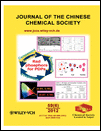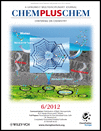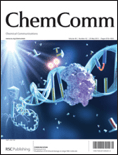
RSC Advances
Scope & Guideline
Empowering Scientific Progress with Rigorous Research
Introduction
Aims and Scopes
- Materials Science and Engineering:
Focuses on the design, synthesis, and characterization of novel materials, including nanomaterials, polymers, and composites, emphasizing their applications in energy, electronics, and healthcare. - Environmental Chemistry and Sustainability:
Covers research on environmental pollutants, waste management, and sustainable practices, including the development of green technologies and materials for pollution remediation. - Medicinal Chemistry and Drug Development:
Explores the synthesis, characterization, and biological evaluation of pharmaceutical compounds, drug delivery systems, and therapeutic agents, with an emphasis on innovative approaches to combat diseases. - Nanotechnology and Nanomaterials:
Investigates the synthesis, properties, and applications of nanostructured materials, including their role in catalysis, sensing, and drug delivery, as well as their environmental impact. - Computational Chemistry and Theoretical Studies:
Engages in theoretical modeling and computational studies to predict the behavior of new compounds and materials, offering insights into their structure, reactivity, and potential applications. - Chemical Engineering and Process Optimization:
Focuses on the development and optimization of chemical processes, including reaction engineering, separation processes, and the utilization of biocatalysts.
Trending and Emerging
- Sustainable and Green Chemistry:
An increasing emphasis on sustainability and environmentally friendly practices, including the development of green catalysts, renewable materials, and waste recycling methods, is becoming a significant trend. - Advanced Drug Delivery Systems:
Research into novel drug delivery mechanisms, including nanocarriers and smart hydrogels, is on the rise, particularly in the context of targeted and controlled drug release for cancer treatment. - Photocatalysis and Environmental Remediation:
The application of photocatalytic materials for the degradation of pollutants and wastewater treatment is gaining momentum, reflecting a growing concern for environmental sustainability. - Machine Learning in Chemistry:
The integration of machine learning techniques to predict material properties, optimize chemical processes, and design new compounds is emerging as a robust area of research. - Biomaterials and Tissue Engineering:
There is a notable increase in research focused on biocompatible materials, hydrogels, and scaffolds for tissue engineering and regenerative medicine applications. - 2D Materials and Their Applications:
The exploration of two-dimensional materials, such as graphene and transition metal dichalcogenides, for various applications including electronics, photonics, and energy storage is rapidly expanding.
Declining or Waning
- Traditional Organic Synthesis:
Research involving classical organic synthesis methods is becoming less prominent, as there is a shift towards greener and more efficient synthetic pathways, such as those utilizing nanomaterials or biocatalysts. - Inorganic Chemistry without Functional Applications:
There is a noticeable decrease in publications focusing solely on inorganic chemistry without practical applications, as the field increasingly emphasizes the integration of inorganic compounds into functional materials. - Basic Theoretical Studies:
Papers focusing on basic theoretical chemistry without application or practical relevance are less common, as the journal encourages research that demonstrates real-world applications or interdisciplinary connections. - Low-Efficiency Energy Conversion Systems:
Research on traditional energy conversion systems that lack innovation or efficiency improvements is waning, with more focus shifting towards sustainable and high-efficiency alternatives. - Single-Discipline Studies:
As the journal aims to promote interdisciplinary research, studies that remain strictly within a single discipline without connections to broader applications are declining.
Similar Journals

Izvestiya Vysshikh Uchebnykh Zavedenii Khimiya i Khimicheskaya Tekhnologiya
Connecting Scholars in the World of ChemistryIzvestiya Vysshikh Uchebnykh Zavedenii Khimiya i Khimicheskaya Tekhnologiya is a prominent academic journal dedicated to the fields of chemistry and chemical technology, published by the esteemed IVANOVSKOGO KHIMIKO-TEKHNOLOGI TSHESKOGO INST in the Russian Federation. With an ISSN of 0579-2991 and E-ISSN of 2500-3070, this journal has been a crucial platform since its inception in 1980, showcasing significant advancements and research findings, particularly in its converged periods from 1980, 1982, and 2017 to 2024. The journal is ranked Q3 in Chemical Engineering and Chemistry, reflecting its dedication to quality scholarship. Although open access options are currently unavailable, the journal plays a vital role in disseminating knowledge and fostering collaboration among researchers, professionals, and students in these critical scientific domains. Situated in Ivanovo, Russia, it continues to be a focal point for impactful research, making it an essential resource for those aiming to stay at the forefront of innovation in chemistry and chemical engineering.

JOURNAL OF THE CHEMICAL SOCIETY OF PAKISTAN
Catalyzing Discoveries in the World of Chemistry.JOURNAL OF THE CHEMICAL SOCIETY OF PAKISTAN is a premier academic journal published by the Chemical Society of Pakistan, focusing on advancing the field of chemistry through rigorous research and scholarship. Established in 1996, this journal aims to disseminate high-quality research articles, reviews, and insights pertaining to various subfields of chemistry, making substantial contributions to both local and international scientific communities. With a current impact factor placing it in the Q4 category, the journal continues to foster discussions on emerging trends and innovations within the discipline. Additionally, it holds a Scopus rank of #305 out of 408, highlighting its growing influence despite being positioned in the 25th percentile. Although it is not an open-access journal, it provides a crucial platform for researchers and professionals in Pakistan and worldwide. The JOURNAL OF THE CHEMICAL SOCIETY OF PAKISTAN serves as a valuable resource for students, educators, and industry professionals alike, facilitating the exchange of knowledge and promoting advancements in chemical sciences.

JOURNAL OF THE CHINESE CHEMICAL SOCIETY
Exploring the Frontiers of Chemical ScienceJOURNAL OF THE CHINESE CHEMICAL SOCIETY, published by WILEY-V C H VERLAG GMBH, is a vital resource in the field of chemistry, focusing on a broad array of topics pertinent to general chemistry and its advancing sub-disciplines. Established in 1954 and running through 2024, this journal serves as a significant platform for the dissemination of high-quality research, showcasing innovative findings and developments within the chemical sciences. With its Q3 category ranking and positioning at Rank #203 in General Chemistry per Scopus, it reflects the journal's commitment to research excellence and impact. While not an open-access publication, it ensures accessibility to a global audience, making it an essential tool for researchers, professionals, and students alike seeking to stay informed and engaged in the evolving landscape of chemistry.

EGYPTIAN JOURNAL OF CHEMISTRY
Exploring the Intersections of Chemistry and InnovationThe Egyptian Journal of Chemistry, published by the National Information & Documentation Centre (NIDOC), serves as a vital platform for disseminating novel research and advancements in the field of chemistry and its interdisciplinary applications. Established in 2004 and continuing its publication through 2024, this journal encapsulates a diverse range of topics including Biochemistry, Chemical Engineering, and Materials Science, reflected in its respectable Scopus rankings. With an array of Quartile rankings indicating its varying impact across different categories, scholars can benefit from its insights into innovative solutions and methodologies that address pressing scientific challenges. Although it currently does not operate under an open access model, researchers and students are encouraged to leverage its findings as it plays a pivotal role in the academic landscape of Egypt and beyond. For those engaged in chemical research, the Egyptian Journal of Chemistry stands as an essential resource, contributing significantly to the global body of scientific knowledge.

ChemPlusChem
Unlocking the Future of Chemistry, One Article at a TimeChemPlusChem is a premier journal published by WILEY-V C H VERLAG GMBH, dedicated to the vibrant field of chemistry. With an ISSN of 2192-6506 and an impressive Q1 ranking in Scopus's 2023 category for miscellaneous chemistry, this journal serves as a significant platform for the dissemination of high-quality research and innovative findings. Since its inception in 2012, ChemPlusChem has fostered interdisciplinary collaborations, encapsulating a wide array of topics within chemistry that facilitate scientific advancement and education. The journal features a robust open access system, enabling extensive visibility for authors while providing easy-to-access resources for researchers, professionals, and students globally. Located in Weinheim, Germany, ChemPlusChem reflects international standards and ambitions, striving to enrich the global scientific community through rigorous research and engaging scientific discourse.

Trends in Chemistry
Unveiling the Cutting-Edge of ChemistryTrends in Chemistry, published by CELL PRESS, stands at the forefront of the multidisciplinary field of chemistry, offering cutting-edge research and insights that shape contemporary scientific discourse. With its impressive rank of #12 out of 408 in the General Chemistry category of Scopus—placing it in the 97th percentile—this journal represents the pinnacle of academic excellence and innovation. Since its inception in 2019, it has provided a platform for sharing pivotal developments and trends in the chemical sciences, making it an invaluable resource for researchers, professionals, and students alike. Although it operates under subscription access, Trends in Chemistry is dedicated to expanding the frontiers of knowledge and fostering a vibrant academic community. Its Q1 quartile ranking underscores its significance and authority in the field, ensuring that it remains an essential reference point for anyone engaged in the ever-evolving world of chemistry. With its impactful contributions, Trends in Chemistry not only reflects current advancements but also drives future innovation in the discipline.

Eurasian Journal of Chemistry
Catalyzing Global Insights in Chemical ResearchEurasian Journal of Chemistry is an emerging open-access journal published by KARAGANDA STATE UNIVERSITY in Kazakhstan. With a focus on the diverse and dynamic field of chemistry, this journal aims to disseminate cutting-edge research and innovative findings from various branches of chemistry, engaging a global audience of researchers, professionals, and students. Despite its recent inception in 2023, the journal is strategically positioned within the field, currently ranked in the fourth quartile of Scopus for General Chemistry, indicating its potential for growth and contribution to the scientific community. The ISSN of the journal is 2959-0663 with an electronic counterpart of 2959-0671, ensuring wide accessibility to its rich content. With an open-access model, the Eurasian Journal of Chemistry promotes the sharing of knowledge and advances in research to foster collaboration and inspiration across the globe.

Reactions
Fostering Collaboration in Chemical EngineeringReactions is a dynamic open-access journal published by MDPI, dedicated to the advancement of research in the fields of Chemical Engineering and Chemistry. Launched in 2020, the journal aims to provide a platform for scientists and researchers to share their findings and innovations, facilitating the synthesis and dissemination of knowledge within the global academic community. With an impact factor that reflects its growing influence, Reactions ranks 47th in the Chemical Engineering category and 72nd in Chemistry on Scopus, placing it within the vibrant landscape of contemporary chemical research. Housed in the picturesque city of Basel, Switzerland, the journal is committed to open access, ensuring that its high-quality content is readily available to all. This commitment not only enhances visibility but also fosters collaboration among researchers, professionals, and students striving to push the boundaries of chemical sciences. As we look towards 2024 and beyond, Reactions continues to encourage submissions that explore groundbreaking methodologies, innovative applications, and transformative theoretical frameworks in chemistry and chemical engineering.

CHEMICAL COMMUNICATIONS
Elevating the discourse in chemical research and applications.Chemical Communications, published by the esteemed Royal Society of Chemistry, is a prominent journal within the field of chemical science, focusing on the dissemination of cutting-edge research in a variety of sub-disciplines including catalysis, materials chemistry, and electronic materials. Operating without an open access model, this journal provides critical insights from contributors around the globe, enhancing our understanding of complex chemical interactions and innovative applications. Ranked in the top quartile for several categories such as Ceramics and Composites, and Metals and Alloys, Chemical Communications boasts impressive Scopus rankings, securing strong positions across multiple fields and showcasing its influence within the scientific community. The journal is committed to advancing knowledge and fostering collaboration among researchers, professionals, and students, making it an invaluable resource for those looking to stay abreast of the latest advancements in chemistry and materials science. With a publication history dating back to 1965 and continuing into 2024, its rich archive serves as a vital repository of chemical research and development.

Frontiers of Chemical Science and Engineering
Connecting Researchers for Global ImpactFrontiers of Chemical Science and Engineering is an esteemed journal published by SPRINGER, dedicated to advancing the rapidly evolving domain of chemical engineering. Located in New York, USA, this journal provides a vibrant platform for disseminating groundbreaking research and innovative methodologies in the field. With an impressive Q1 ranking in Chemical Engineering and a Scopus ranking of 54 out of 273, it occupies a prominent position, reflecting its high impact and relevance among academic circles. Since its inception in 2011, it has fostered interdisciplinary collaboration, encompassing diverse topics such as process engineering, environmental sustainability, and nanotechnology, making it a vital resource for researchers, professionals, and students alike. The journal's open access policy further enhances accessibility, ensuring that cutting-edge research is readily available to a global audience. As the field continues to evolve, contributions to Frontiers of Chemical Science and Engineering play an essential role in shaping future advancements and empowering the next generation of engineers.